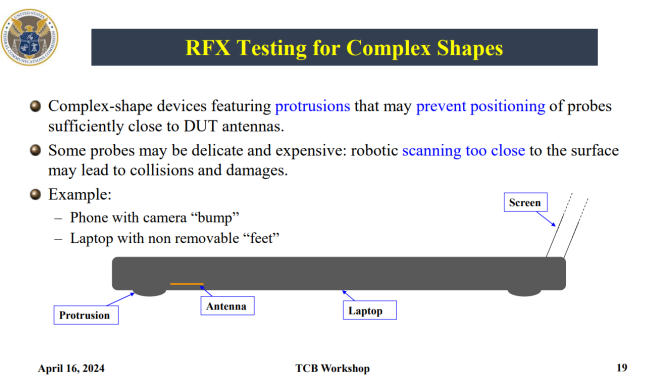Oct 22, 2024
Regulatory Updates Presented at Recent TCB Council Workshop
At the October TCB Council Workshop in Baltimore, USA, important technical and regulatory information for the wireless industry was presented by regulators and other speakers. The good news: SPEAG’s latest solutions meet all current and upcoming requirements.
The latest TCB Council Workshop took place on October 15 – 17 in Baltimore, Maryland, USA. The workshop consisted of three days of interesting presentations and discussions on the state of international regulations, standards, and scientific development relevant to certification of wireless products.
In Canada, ISED introduced several recent guidelines, including technical requirements for the 60 GHz band (RSS-210, Annex J) and bands above 95 GHz (RSS-295). Upcoming guidance includes extended time-average specific absorption rate (SAR) requirements (RSS-102.SAR.MEAS, Issue 2) and expanded procedures for incident power density (IPD) for the 6 – 300 GHz range (Issue 2 of both RSS-102.IPD.MEAS and RSS-102.IPD.SIM). Please note that SPEAG’s DASY8/6 Module WPT users do not have to consider the new guidance (Notice 2024-DRS0004) for nerve stimulation: the module accurately assesses the maximum induced exposure without approximations and MAGPy incorporates a conservative approach to maximum field exposure extrapolation.
FCC will soon require 100% hearing aid compatibility for mobile phones sold in the United States. On October 17, 2024, FCC issued a news release on a new Report and Order 24-112. Compliance with ANSI standard C63.19 for radiofrequency (RF) emissions must be met by 85% of mobile phones today and 100% within 24 months for mobile phone manufacturers, and within 42 months for wireless service providers. This caps off a process of regulatory engagement and standards development that the FCC started in 1995.
Dr. Alfonso Tarditi, Technical Research Branch Chief at the FCC, gave updates on several important topics on RF exposure, including measurement considerations for devices with complex shapes, and verifying maximum SAR for devices using dynamic antenna tuning. Streamlined regulations for faster approval were also discussed, such as the removal of carrier aggregation from pre-approval guidance. During the Q&A session, he confirmed that SPEAG’s advanced tools can be applied without submitting any pre-approval guidance (PAG) as long the post-processor does not include any simulations (e.g., Application Note: IPD Evaluations of Non-Planar Devices, e.g., Camera Modules). SPEAG will provide additional information soon.

Slide from FCC presentation on scanning concept for devices with protrusions. Presented at October 2024 TCB Council Workshop.
The European regulatory status was again summarized by Michael Derby of Element. There will likely be a new EU requirement that standards (e.g., CENELEC) are free of charge if they are listed in the Official Journal. CENELEC is revising its exposure standards to add the exposure limits directly, as it can no longer have normative references to non-EN standards.
On the last day of the workshop, Kaitlin O’Keefe and Mark Biros from RF Safety Lab expertly summarized the state-of-the-art and unique challenges of wireless power transfer (WPT) exposure assessment. Challenges include the influence of the selected load (e.g., mobile phone), and changes that occur during charging (charging rate, charging frequency, device heating). Techniques and procedures to solve these challenges were discussed. The good news is that SPEAG will release MAGPy V2.8 in the next months that provides automated measurement solutions addressing these challenges.
The IT’IS Foundation’s Prof. Niels Kuster discussed the current scientific challenges and solutions for exposure assessment. He described:
- the latest refinement of the equivalent source reconstruction for the evaluation of IPD in the reactive near-field;
- the method that enables the assessment of IPD conformal to the device surface. He also offered a solution for an issue raised by FCC, namely, using specific phantoms to assess transmitters with very special form factors. The manufacturing and validation of such phantoms takes 2 – 4 weeks;
- the progress in assessing absorbed power density (APD);
- the issues to crack the deadlock for fast SAR systems;
- and most importantly, the research performed for robust and automated evaluation of exposure mitigation techniques, such as time average SAR, proximity sensors, motion sensors, use case dependent power budgets, etc.
The IT’IS slides are available here. DASY8/6, and its modules for SAR, incident power density (mmWave), absorbed power density (APD), wireless power transfer (WPT), hearing-aid compatibility (HAC), and proximity sensor evaluation (SENS), have been developed in close collaboration with regulators and active participation in the relevant standards to meet all of the above requirements.
For further information, please contact us at info@speag.swiss or any of our sales channels.
Kind regards,
Your SPEAG Team




